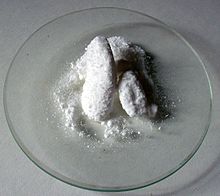Sodium tungstate

| |
| Names | |
|---|---|
| IUPAC name Sodium tungstate | |
| Identifiers | |
3D model (JSmol) |
|
| ECHA InfoCard | 100.033.389 |
PubChem CID |
|
| RTECS number |
|
| UNII | |
CompTox Dashboard (EPA) |
|
| |
| |
| Properties | |
| Na2WO4 | |
| Molar mass | 293.82 g/mol (anhydrous) 329.85 g/mol (dihydrate) |
| Appearance | White rhombohedral crystals |
| Density | 4.179 g/cm3 (anhydrous) 3.25 g/cm3 (dihydrate) |
| Melting point | 698 °C (1,288 °F; 971 K) |
| 57.5 g/100 mL (0 °C) 74.2 g/100 mL (25 °C) 96.9 g/100 mL (100 °C) | |
| Solubility | slightly soluble in ammonia insoluble in alcohol, acid |
| Structure | |
| Rhombic (anhydrous) orthorhombic (dihydrate) | |
| Hazards | |
| Safety data sheet (SDS) | External MSDS |
| Related compounds | |
Other cations |
Lithium tungstate Caesium tungstate |
Except where otherwise noted, data are given for materials in their standard state (at 25 °C [77 °F], 100 kPa). | |
Sodium tungstate is the inorganic compound with the formula Na2WO4. This white, water-soluble solid is the sodium salt of tungstic acid. It is useful as a source of tungsten for chemical synthesis. It is an intermediate in the conversion of tungsten ores to the metal.[1]
Preparation and structure
Sodium tungstate is obtained by digestion of tungsten ores, the economically important representatives of which are tungstates, in base. Illustrative is the extraction of sodium tungstate from wolframite:[1]
- Fe/MnWO4 + 2 NaOH + 2 H2O → Na2WO4·2H2O + Fe/Mn(OH)2
Scheelite is treated similarly using sodium carbonate.
Sodium tungstate can also be produced by treating tungsten carbide with a mixture of sodium nitrate and sodium hydroxide in a fusion process which overcomes the high exothermicity of the reaction involved.
Several polymorphs of sodium tungstate are known, three at only one atmosphere pressure. They feature tetrahedral orthotungstate dianions but differ in the packing motif. The WO2−
4 anion adopts a structure like sulfate (SO2−
4).[2]
Reactions
Treatment of sodium tungstate with hydrochloric acid gives the tungsten trioxide or its acidic hydrates:
- Na2WO4 + 2 HCl → WO3 + 2 NaCl + H2O
- Na2WO4 + 2 HCl → WO3·H2O + 2 NaCl
This reaction can be reversed using aqueous sodium hydroxide.
Uses
The dominant use of sodium tungstate is as an intermediate in the extraction of tungsten from its ores, almost all of which are tungstates.[1] Otherwise sodium tungstate has only niche applications.
In organic chemistry, sodium tungstate is used as catalyst for epoxidation of alkenes and oxidation of alcohols into aldehydes or ketones. It exhibits anti-diabetic effects.[3]
Solutions of sodium and lithium metatungstates are used in density separation. Such solutions are less toxic than bromoform and methylene iodide, but still have densities that fall between a number of naturally coupled minerals.[4]
Sodium tungstate is a competitive inhibitor of molybdenum; because tungsten is directly below molybdenum on the periodic table, it has similar electrochemical properties. Dietary tungsten reduces the concentration of molybdenum in tissues.[5] Some bacteria use molybdenum cofactor as part of their respiratory chain; in these microbes, tungstate can replace molybdenum and inhibit the generation of energy by aerobic respiration. As such, one niche use of sodium tungstate is in experimental biology—where it has been found that adding sodium tungstate to the drinking water of mice inhibits the growth of Enterobacteriaceae (a family of endogenous opportunistic pathogens) in the gut.[6]
Sodium tungstate has been researched as a potential treatment for infertility under the code OXO-001.[7][8][9]
References
- ^ a b c Lassner E, Schubert WD, Lüderitz E, Wolf HU (2005). "Tungsten, Tungsten Alloys, and Tungsten Compounds". Ullmann's Encyclopedia of Industrial Chemistry. Weinheim: Wiley-VCH. doi:10.1002/14356007.a27_229. ISBN 978-3527306732.
- ^ Pistorius CW (June 1966). "Phase diagrams of sodium tungstate and sodium molybdate to 45 kbar". The Journal of Chemical Physics. 44 (12): 4532–4537. Bibcode:1966JChPh..44.4532P. doi:10.1063/1.1726669.
- ^ Domínguez JE, Muñoz MC, Zafra D, Sanchez-Perez I, Baqué S, Caron M, et al. (October 2003). "The antidiabetic agent sodium tungstate activates glycogen synthesis through an insulin receptor-independent pathway". The Journal of Biological Chemistry. 278 (44): 42785–42794. doi:10.1074/jbc.M308334200. PMID 12925525.
- ^ Skipp GL, Brownfield IK (1993). Improved density gradient separation techniques using sodium polytungstate and a comparison to the use of other heavy liquids (PDF) (Report). US Geological Survey.
- ^ Considine GD, ed. (2005). "Molybdenum". Van Nostrand's Encyclopedia of Chemistry. New York: Wiley-Interscience. pp. 1038–1040. ISBN 978-0-471-61525-5.
- ^ Zhu W, Winter MG, Byndloss MX, Spiga L, Duerkop BA, Hughes ER, et al. (January 2018). "Precision editing of the gut microbiota ameliorates colitis". Nature. 553 (7687): 208–211. Bibcode:2018Natur.553..208Z. doi:10.1038/nature25172. PMC 5804340. PMID 29323293.
- ^ Canals I, Cotán D, Torres R, Horcajadas JA, Arbat A (2021). "Sodium tungstate increases embryo adhesion through a direct effect on endometrial cells". Human Reproduction. 36 (Supplement_1): deab130.402. doi:10.1093/humrep/deab130.402.
- ^ Arbat A, Gonzalez-Bulnes A, Pérez-Villalobos N, Canals I (2021). "Oral administration of sodium tungstate to a swine model improves embryo implantation rate". Human Reproduction. 36 (Supplement_1). doi:10.1093/humrep/deab130.355.
- ^ Devlin H (7 July 2024). "Fertility drug could lead to 7% increase in live births after IVF, trials show". The Guardian.
Further reading
- Altirriba J, Barbera A, Del Zotto H, Nadal B, Piquer S, Sánchez-Pla A, et al. (August 2009). "Molecular mechanisms of tungstate-induced pancreatic plasticity: a transcriptomics approach". BMC Genomics. 10: 406. doi:10.1186/1471-2164-10-406. PMC 2741493. PMID 19715561. Lay summary in: "The Anti-Diabetic Effects Of Sodium Tungstate Revealede". ScienceDaily. 28 August 2009.
